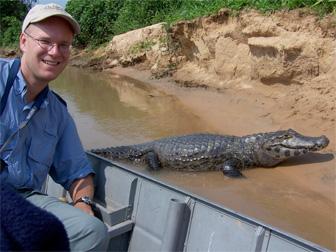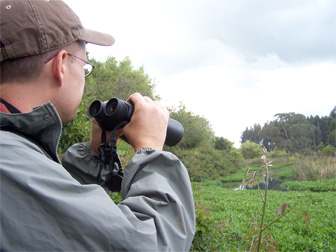Matt Miller is director of communications for The Nature Conservancy in Idaho, a position he’s held for ten years. He is responsible for the chapter’s publications and digital media. He writes for the Conservancy’s blogs Cool Green Science and Idaho Nature Notes. He has also completed two conservation fellowships for the Conservancy’s programs in Colombia and Micronesia. In his spare time, he is editor of Backcountry Journal and a freelance writer with credits in Grist, Living Bird, Bugle, Sports Afield and many other publications. Matt is a board member of the Outdoor Writers Association of America and a regular speaker on conservation topics. He has traveled to six continents in search of wildlife and stories. Most recently, he’s written about the plight of Pacific Islanders caused by rising sea levels and economic hardships. Matt lives in Boise, Idaho with his wife Jennifer, who promotes sustainable agriculture for the Northwest Center for Alternatives to Pesticides.
Morgan Erickson-Davis: How did you get your start as a writer?
 Matt Miller |
Matt Miller: I started making wild animal sounds before I could talk. I grew up in a place where I could explore the woods, where I could go fishing and hunting with my family. And I was absolutely mad about books (still am). My heroes were all writers. By the time I was 12, I knew with great clarity that I wanted to be an outdoor writer. But I didn’t start my career writing about conservation issues. The day after graduating with a creative writing degree, I was hired by a performing arts center as a writer and editor. It is an important lesson, I think: Take writing jobs however they come, and don’t worry about subject matter. That first job required me to edit and produce more than 50 full-length performance programs a year, with pretty intense deadlines. In retrospect, I did a mediocre job at it. But the work habits, the hard lessons learned, the skilled mentors and creative environment have all served me well, first as a freelance writer and now with my career with The Nature Conservancy. I’ve been working for the Conservancy since 2001. When I was offered the position, I said it was a dream job. It remains so to this day.
Morgan Erickson-Davis: What conservation issues most interest you?
Matt Miller: I am fascinated by human connections to the natural world, particularly wildlife. I love learning and thinking about complex issues that relate to wildlife, whether it’s invasive species, or the role of hunting, or sustainable forest harvest, or the reintroduction of predators. These issues are as much about values as they are about science. I love critters: I consider myself an old-fashioned amateur naturalist. I like being among the wild things, and I like writing about them. I am also drawn to conservation that produces tangible results, whether that’s a conservation easement on private land, or restoring a stream so that salmon can return. Finally, we all eat, and I really see eating as a conservation act: I am an advocate for local, organic and wild foods.
Morgan Erickson-Davis: How did you become interested in the human connections to the natural world? Is there any particular area/example which interests you the most?
 Matt Miller |
Matt Miller: There’s a wonderful post-apocalyptic novel called Beasts by John Crowley. In it, the humans decide they’ve inflicted enough damage on the world, and given their technological knowledge on sustaining life, build a tower for the world’s people to live in permanently. The people may never leave—giving the rest of the world to “nature.” I sometimes fear certain environmentalists dream of such a world. There’s an addictive idea that nature is “out there” and should be just left alone. I understand that perspective, but I’ve never seen nature as something separate from my life. I’ve always been outside, watching and observing animals, hunting and fishing, or just wandering around. I think we can only solve environmental problems when we recognize that humans are a part of this world, and a part of nature. The separation is false. One example that comes to mind is forest harvest. It’s “conventional wisdom” that environmentalists are against cutting trees. The problem is, I—like most of us–read books, live in a home, print on office paper. The publications I produce for The Nature Conservancy come from trees. So how could I possibly pronounce that all tree cutting is wrong? The reality is, tree cutting isn’t always wrong. The Nature Conservancy works in North Idaho on forest issues. There are private forests in that area that are used extensively by wildlife like grizzly bears. A grizzly can move through a clearcut and survive quite well. It will forage for berries and eat newly grown grasses. But if that land is developed with houses, the grizzly is in trouble. Houses mean roads, dogs and human disturbance. The Conservancy is working with forest product companies to keep the land as forest. The companies avoid cutting when bears are in the area. This is keeping bears in the woods, yes. But it’s also keeping workers in timber mills. I know environmentalists love grizzlies. I do, too. But can they find it in themselves to love clearcuts? Even if it benefits the community and bears and moose and a whole bunch of other things?
Morgan Erickson-Davis: Your blending of social issues and conservation is unique among environmental writers. How do you think this is reflected in the environmental science community as a whole? Was there any resistance to your shark finning article in which you sympathize with those who do the finning?
Matt Miller: I think the environmentalists—or at least some of them– are getting there. The Nature Conservancy’s approach is to work with people, and that has been the case for the organization’s 60-year history. Those values mirror my own, which is why I work here. But, in part, for me, I also think blending social issues and conservation comes from my love of stories. I love hearing about peoples’ connections to the land.
 Matt Miller |
A few years ago, I spent a day with a man named Warner Glenn in Arizona. Warner is a rancher. He is also famous as a hunting guide. He takes paying clients out hunting mountain lions. I suspect a lot of urban environmentalists would read those facts and write him off as the enemy. They’d be completely wrong. Warner and his wife Wendy have taken a lead in conserving the Malpais Borderlands, a beautiful grassland in southern Arizona. They have recorded the first jaguars seen in Arizona in decades. And Warner knows the land incredibly well. Being out on the grasslands with Warner is like being with a translator. He sees things that the rest of us miss. I’m proud to work for an organization that recognizes the value people like the Glenns bring to conservation.
The shark finner was much the same. Shark finners are easy villains. But until you’ve walked in that young man’s shoes, how can you really judge? Of course, when my story was posted on Facebook, there were still people who responded that shark finners were evil. Period. I am not suggesting that all ranchers or lion hunters or loggers or shark finners are rustic, romantic heroes who know more about land, water and wildlife than any city slicker. That’s simply not the truth. Over-simplification—of either side of the environmental debate—doesn’t work. When you listen to someone’s story—really listen—you may find that person has something important to say.
Morgan Erickson-Davis: Would you mind elaborating on the importance of eating locally? What turned you into a locavore?
Matt Miller: Well, I grew up in a rural area, so gardens, free-range eggs and wild game—local food, all—were part of my reality. Then I went to college, where I frankly didn’t cook. The microwave and take-out dinners were my reality. When I first started dating my wife, I had her over for dinner at my apartment one evening. She was impressed by how clean my oven was. I didn’t have the heart to tell her that it was because I had never turned it on. Not once. I had read all the right books but it just seemed difficult. When we moved to Idaho from Pennsylvania, I felt disconnected from our previous life—away from family and friends and the familiar. Food was the way we found out about our new home—the taste of place, if you will. The farmers market became a ritual; farmers became our friends. There are a lot of reasons for eating local—from the environmental benefits to supporting the local economy. But for me, the big reason is this: I love the taste and the diversity. The bright blue potatoes fried with organic lamb chorizo, wild duck in wine sauce, kale, blazing hot peppers, spaghetti sauce from tomatoes grown in our backyard. I know where my food came from. It came from where I live. That’s one of the best connections to nature of all.
Morgan Erickson-Davis: What would you say is the most important thing you’ve learned about environmental writing?
 Matt Miller |
Matt Miller: It may sound obvious, but environmental writing—whether for a blog, a magazine, a newsletter or an organization—has to be about story. Too often, environmentalists get wrapped up in jargon, in complicated science or in policy. But the environmental movement is about real places, real creatures and real people. Those people have stories to tell. Listen to them. My most rewarding time with The Nature Conservancy has been in the field, listening to stories: A Colombian rancher who looked to the wide-open spaces and birds around him to provide hope through decades of unspeakable violence. The Idaho rancher who loved telling me about lassoing wild animals—but who also is providing more water for migrating salmon. The timber mill workers who share their frustration about the loss of good-paying jobs. A Micronesian conservationist who began his career chopping the fins off sharks with machetes. People have stories that they really want to share. I see my job with The Nature Conservancy as connecting people to conservation through these stories.
Morgan Erickson-Davis: Any advice for aspiring environmental writers?
Matt Miller: Two quotes come to immediately to mind: Ed Abbey’s admonition that “It is not enough to fight for the land; it is even more important to enjoy it” and Thomas McGuane’s advice to “read like a sonofabitch.” That pretty much sums it up. And, actually, for your reading regime, it wouldn’t be a bad idea to begin with Abbey and McGuane.
Matt’s articles for The Nature Conservancy can be found at blog.nature.org/author/mmiller/. He’s also on Twitter at @eatguineapigs, and Facebook at Matthew L. Miller.
Related articles
Economic crisis hits conservation but may offer opportunities, says TNC president
(March 03, 2009) In 2008 The Nature Conservancy (TNC) surprised the conservation world when it selected Mark Tercek, an investment banker from Goldman Sachs, as its new president and CEO. But for people who have worked with Tercek, the move made strategic sense – Tercek was a leading figure in the Goldman’s effort to improve its environmental record. In 2005 Tercek was appointed to head up the firm’s Environmental Strategy Group, which develops and implements its environmental policy, and its Center for Environmental Markets, an initiative that examines market-based solutions to environmental challenges.













